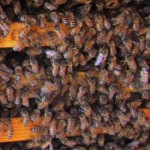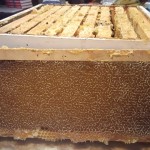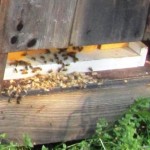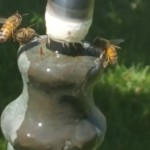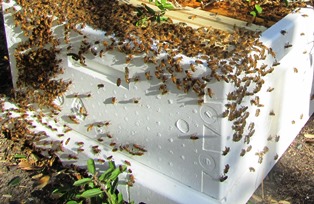Swarms of Honeybees Mark an Early Start to Spring
On my birthday in late March this year, I noticed a large swarm of honeybees in my neighbor’s yard. The weather was warm and perfect for the overpopulated hive to release some of its citizens to find a new home with their new fertile queen.
Then on April 8–Easter Sunday, my own Italian honeybees swarmed. Our hive had made it through the winter although the bees had battled hive beetles. But just as hubby and I were on ladders that Easter afternoon building a new trellis for our grapes, I heard the low hum of thousands of bees lifting skyward.
Sure enough, the new swarm had emerged from our hive. We dropped our drills, screws, and lumber. He banged on cooking pot with a wooden spoon (to disorient the bees and encourage them to land in a nearby tree) while I set up the extra hive box with empty frames.
Suited up in beekeeper gear, my hubby clipped a couple of branches from the pin oak tree to make it possible to do a hard shake on the one limb the bees had coalesced around. He placed the prepared hive box beneath the tree. Our beekeeper neighbor joined us and helped. Then, a hard shake and boom…the entire colony dropped into the hive box.
We waited until after dark to ease the hive box lid in place and then take the entire box to its permanent location in a sunny, dry spot in the garden.
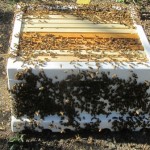
A hive box without its lid. The bees do a waggle dance to tell the bees still in the air that this is their new home
The work on the trellis that will serve as our grape arbor was nearly complete when the swarm occurred. Now the finishing touches will have to wait for another day.
De-Bugging My Honeybee Hive Box of Beetles
I’ve been dealing with a beetle problem in my honeybee hive since fall. When my knowledgeable beekeeper neighbor called to suggest opening the hive, I readily agreed.
The dreaded hive beetle–tinier than a honeybee–can destroy a hive. Its destruction isn’t on the bees themselves, but rather the comb, honey, and pollen. As the population of hive beetle increases and the destruction mounts, the bees will abandon the hive.
Previously, my neighbor had used two types of hive beetle traps in my hive–Beetle Bee-Gone was an all-natural, chemical-free sheet that looked like a fabric softener product for the dryer. We had placed this on top of the frames before closing the hive last fall. The other product was a narrow plastic tray inserted between the frames that held vegetable oil.
We discovered that the sheet worked well, trapping lots of hive beetles. But the frame with oil had no beetles. I dumped it. We checked the brood box–and were excited to see it full of unborn babies.
After harvesting eight frames of honey, we reversed the brood box, scraped away the burr comb, and positioned a super on top of the hive box with empty frames for spring honey. Before closing the hive, we inserted two clean sheets of Beetle Bee-Gone.
Today, the bees are active and out foraging for pollen. Flowers are everywhere and the fruit trees in the neighborhood have broken bud. It remains to be seen if the Bay Area gets any more rain or bitterly cold days ahead. Probably by April 1, I’ll hang the swarm catcher and hope to add a new population of bees to my colony.
______________________________________________________________________________
If you enjoy reading about keeping bees, growing heirloom vegetables and fruits, caring for chickens, or self care for healthy living, check out my Henny Penny Farmette series of cozy mysteries: A BEELINE TO MURDER, THE MURDER OF A QUEEN BEE, and HIVE OF HOMICIDES. Click on the URL below. Also see newest nonfiction for healthy living: RITUALS FOR LIFE.
http://tinyurl.com/ya5vhhpm
A Hive of Homicides or Hive Demise
The title of the third novel in my Henny Penny Farmette series suggests loss of bees and murderous intent. No beekeeper wants to lose a hive, regardless of how it happens–whether some invader wants to kill the bees, go after the honey, or use the hive as a host for proliferation of its own species.
I’m not one-hundred percent positive why I lost a hive this year. My best guess was that the demise was due (not to homicide but rather) to a tiny little pest, possibly a beetle that weakened it so that the bees and queen fled leading to the hive’s demise.
My beekeeper neighbor and I spotted a small beetle and treated for it. My best efforts to keep my small bee house and the area around it clean as well as doing frequent hive inspections wasn’t enough. Now, I’m considering moving my remaining hive onto a higher, drier, sunnier location.
I’ll do it at night which is the correct time to move bees. You just put a little strip of packing foam along the hive entrance, gently move the hive, and place it in the new location. Remove the foam strip so the bees can leave at dawn and make sure there’s a water source nearby.
The bees will likely accept the move if there is water and food in the area. I like planting perennial bee gardens and flowers and bulbs with high nectar value for bloom throughout the year.
Since hives can be compromised by wax moths, hive beetles, and other pests (as well as parasites and diseases), frequent inspections to decipher a problem and treat it before it destroys your hive is imperative.
With supers (smaller hive boxes with ten frames each) on the hive in June, the bees will forage on abundant flowers and produce honey that can be taken off in July. That’s also the time to inspect for mites because these populations tend to swell during summer.
________________________________________________________________
If you’re interested in beekeeping and other farmette topics, check out my Henny Penny Farmette series of mysteries. All are available to order online at Amazon, Barnes and Noble, and other retailer sites as well as traditional bookstores everywhere.
Honeybee Hive Pests Include Real Vampires
Every beekeeper wants to keep his or her hives healthy. Staying on top of your bee’s health means early detection and treatment of pests in the hive such as Varroa mites, trachea mites, hive beetles, and wax moths.
Varroa mites–these small reddish brown pests are akin to tiny vampires, feasting on your bees’ blood. Non-medicinal approaches to treating for these mites include introducing a screened bottom board. Mites fall through and cannot re-enter the hive to reattach to the bees. Also a powdered sugar dusting of your hives’ top bars can dislodge mites.
Tracheal mites–these pests are more difficult to detect. My beekeeper neighbor showed me infant baby bees with partial wings and said he believed it was the work of tracheal mites. To rid your hives of these pests, you’ll need to use menthol crystals and grease patties.
Hive beetles–if you see an insect with a hard, small black shell in corners and dark places within the hive, you may have hive beetles. They devour bee brood, honey, wax, and pollen. Treat the soil in front of the hive and inside the hive, you can try hive beetle traps or treat chemically. The infected honey will be rejected by the bees and should be considered unfit for human consumption as well.
Wax moths–these nasty little creatures can been seen in honeycomb and leave a silky trail over your hive’s hanging frames. If you see evidence that they’ve tunnel into the wood, know that you’ve had the infestation for a while. Wax moths will weaken a colony. Treat the infected hives with moth crystals formulated to eliminate wax moths in the hive.
Hives that are frequently checked their beekeepers stand the best chance for having healthy colonies of bees.
 Facebook
Facebook Goodreads
Goodreads LinkedIn
LinkedIn Meera Lester
Meera Lester Twitter
Twitter




